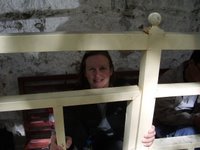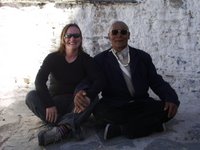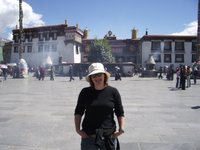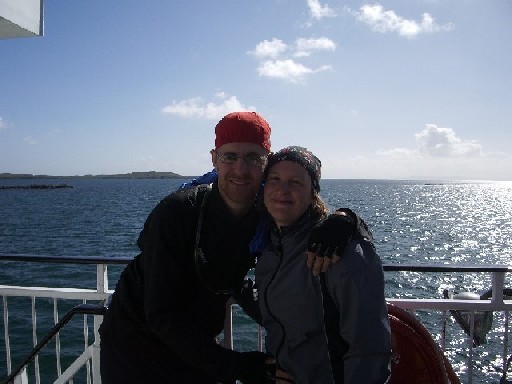Lhasa - Yakitty Yak
We thought Russian beaurocracy was bad. That was before we encountered the Chinese running Tibet. As an example, here's the ridiculous 11 step process to gain access to the Potala Palace in Lhasa:
1. Queue up at front gate the day before we wish to visit.
 2. Man at desk consults 2nd man at desk before sending us round to the side gate.
2. Man at desk consults 2nd man at desk before sending us round to the side gate.3. Queue up at side gate.
4. Reach front of queue where one man tells another man to write some jibberish on Jools' arm whilst 3rd man checks it's been written correctly. 4th man tell us to come back in 2 hours time.
5. Return 2 hours later - show 1st man writing on Jools' arm. 2nd man leads us to a cage and shuts door behind.
 6. Sit in cage, bored.
6. Sit in cage, bored.7. Shuffle up cage to front of queue where on presentation of passports we're handed a slip of paper which gives us the right to come back the next day to buy a ticket.
8. Return next day and queue up at the front gate.
9. Hand over slip of paper to one of three men sitting smoking at a desk - ushered in.
10. Climb about 10,000 steps to ticket office.
11. Buy ticket and enter.
 Anyways, despite the hassle, the Potala (seat of government, monastery, fortress, administrative centre and home of 5th to 13th Dalai Lamas) is one of these places that you can't leave Lhasa having not visited. Stats time; break-it-down:
Anyways, despite the hassle, the Potala (seat of government, monastery, fortress, administrative centre and home of 5th to 13th Dalai Lamas) is one of these places that you can't leave Lhasa having not visited. Stats time; break-it-down:Perched atop Red Mountain, containing over 1000 rooms which rise 130 metres and 13 stories high, the palace took 7000 builders and 1500 artists and craftsmen over 50 years to complete. It's quite an impressive sight both inside(where the multi-tiered, jewel encrusted, golden tombs of past Dalai
 Lamas lie preserved in salt) and out (where funkily bespectacled pilgrims lie in wait for unsuspecting tourists). However, despite the grandeur, the Potala is a sad shell of a place since it's been taken over by the Chinese (I'm free to publish such slander now we've left Tibet). It's run by a few token monks who've been specially vetted by the government, and is much more of a musuem/tourist attraction than a working palace. In fact, your every move is monitored by hundreds of CCTV cameras.
Lamas lie preserved in salt) and out (where funkily bespectacled pilgrims lie in wait for unsuspecting tourists). However, despite the grandeur, the Potala is a sad shell of a place since it's been taken over by the Chinese (I'm free to publish such slander now we've left Tibet). It's run by a few token monks who've been specially vetted by the government, and is much more of a musuem/tourist attraction than a working palace. In fact, your every move is monitored by hundreds of CCTV cameras. Going in search of a "proper Tibetan experience" we ventured into the Jokhang one morning (the holiest temple in the Tibetan Buddhist world) and certainly weren't disapppointed. It was a truly overwhelming experience - from the clackity-clack of the pilgrims prostrating themselves outside the gates, to the endless rows of prayer wheels circling the main temple and the smells of juniper smoke and yak butter. The most impressive sight was the thousands of pilgrims who fill every corner of the temple, moving in a constant, bustling, clockwise stream from room to room, chanting Buddhist incantations and placing offerings at every altar. The devoutness of these people is truly amazing.
Going in search of a "proper Tibetan experience" we ventured into the Jokhang one morning (the holiest temple in the Tibetan Buddhist world) and certainly weren't disapppointed. It was a truly overwhelming experience - from the clackity-clack of the pilgrims prostrating themselves outside the gates, to the endless rows of prayer wheels circling the main temple and the smells of juniper smoke and yak butter. The most impressive sight was the thousands of pilgrims who fill every corner of the temple, moving in a constant, bustling, clockwise stream from room to room, chanting Buddhist incantations and placing offerings at every altar. The devoutness of these people is truly amazing.Another "must do" in Lhasa is the Barkhor circuit, which pilgrims (and tourists) follow clockwise (are you spotting the recurring theme here?) through a maze of picturesque streets around the perimeter of the Jokhang. Again, the stars of the show are the Tibetan people themselves; men with traditional knives and red braided hair, adorned with huge chunks of turquoise; women dripping jewels with their hair in 108 (alledgedly) plaits; old ladies bent over double spinning hand-held prayer wheels twice their size. We did a few laps of the Barkhor every day - a much safer, more fulfilling and painless experience than the equally renowned (for all those who attended our leaving "event" in Edinburgh) Ardmillan Grand Prix.
Other than all that, we stayed in the Yak Hotel, ate yak burgers, yak steaks, yak sizzlers and other assorted yak dishes without actually spotting a real life yak.
Cribbage Update: Jools 12 Kev 8



0 Comments:
Post a Comment
<< Home